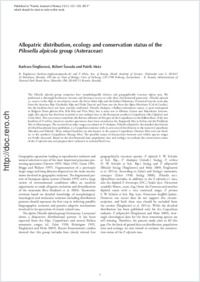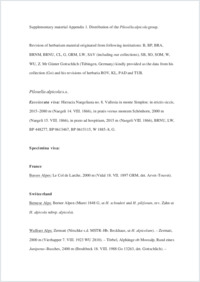Allopatric distribution, ecology and conservation status of the Pilosella alpicola group (Asteraceae)
- Šingliarová, Barbora Inst. of Botany, Slovak Academy of Sciences, Bratislava, Slovakia
- Šuvada, Róbert Inst. of Botany, Slovak Academy of Sciences, Bratislava, Slovakia
- Mráz, Patrik Inst. of Botany, Slovak Academy of Sciences, Bratislava, Slovakia - Dept of Biology, University of Fribourg, Switzerland
-
2013
Published in:
- Nordic Journal of Botany. - 2013, vol. 31, no. 1, p. 122–128
English
The Pilosella alpicola group comprises four morphologically distinct and geographically vicariant alpine taxa. We performed a thorough herbarium revision and literature survey to infer their distributional pattern(s). Pilosella alpicola s.s. occurs in the Alps in two disjunct areas: the Swiss Valais Alps and the Italian Dolomites. Historical records come also from the Austrian Alps (Gurktaler Alps and Hohe Tauern) and from one site from the Alpes Maritimes (Col de Larche), but the localities have not been recently confirmed. Pilosella rhodopea, a Balkan subendemic taxon, is quite widespread in Bulgaria (Stara planina Mts, Rila Mts and Pirin Mts), but is more rare in Albania, Greece and Macedonia. Interestingly, this species has also been recorded at two isolated sites in the Romanian southern Carpathians (the Căpăţînii and Cozia Mts). This occurrence underlines the floristic affinities of this part of the Carpathians to the Balkan flora. Only two localities of P. serbica, based on voucher specimens, have been recorded so far; Kopaonik Mts in Serbia and the Prokletije Mts in Montenegro. The records from other ranges are related to P. rhodopea. Pilosella ullepitschii, the detailed distribution of which has already been published, is a Carpathian endemic with its core area of distribution in the western Carpathians (Slovakia and Poland). Three isolated localities are also known in the eastern Carpathians (Nemira Mts) and one locality in the southern Carpathians (Bucegi Mts). The possible causes of disjunctions between and within species ranges are briefly discussed. Based on the distributional data, population sizes and ecology, we evaluate the conservation status of the P. alpicola taxa and propose their inclusion in national Red Lists.
- Faculty
- Faculté des sciences et de médecine
- Department
- Département de Biologie
- Language
-
- English
- Classification
- Botany
- License
-
License undefined
- Identifiers
-
- RERO DOC 32332
- DOI 10.1111/j.1756-1051.2012.01603.x
- Persistent URL
- https://folia.unifr.ch/unifr/documents/303055
Other files
Statistics
Document views: 108
File downloads:
- pdf: 225
- Supplementary material: 107

